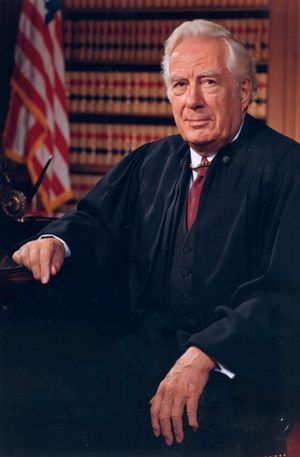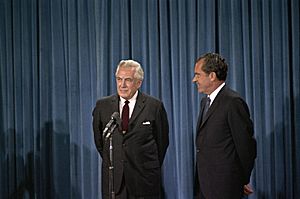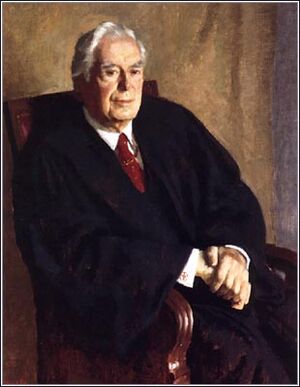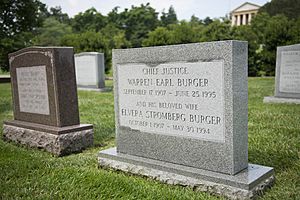Warren E. Burger facts for kids
Quick facts for kids
Warren Burger
|
|
|---|---|

Official portrait, 1969
|
|
| 15th Chief Justice of the United States | |
| In office June 23, 1969 – September 26, 1986 |
|
| Nominated by | Richard Nixon |
| Preceded by | Earl Warren |
| Succeeded by | William Rehnquist |
| 20th Chancellor of the College of William & Mary | |
| In office June 26, 1986 – July 1, 1993 |
|
| President |
|
| Preceded by | Alvin Duke Chandler (1974) |
| Succeeded by | Margaret Thatcher |
| Judge of the United States Court of Appeals for the District of Columbia Circuit | |
| In office March 29, 1956 – June 23, 1969 |
|
| Nominated by | Dwight D. Eisenhower |
| Preceded by | Harold Montelle Stephens |
| Succeeded by | Malcolm Richard Wilkey |
| 11th United States Assistant Attorney General for the Civil Division | |
| In office May 1, 1953 – April 14, 1956 |
|
| President | Dwight D. Eisenhower |
| Preceded by | Holmes Baldridge |
| Succeeded by | George Cochran Doub |
| Personal details | |
| Born |
Warren Earl Burger
September 17, 1907 Saint Paul, Minnesota, U.S. |
| Died | June 25, 1995 (aged 87) Washington, D.C., U.S. |
| Resting place | Arlington National Cemetery |
| Political party | Republican |
| Spouse |
Elvera Stromberg
(m. 1933; died 1994) |
| Children | 2 |
| Education | St. Paul College of Law (LLB) |
| Signature |  |
Warren Earl Burger (September 17, 1907 – June 25, 1995) was an American lawyer and judge. He served as the 15th Chief Justice of the United States from 1969 to 1986. Born in Saint Paul, Minnesota, Burger graduated from the St. Paul College of Law in 1931.
He worked for the government in different roles. In 1953, President Dwight D. Eisenhower made him an Assistant Attorney General. In 1956, Eisenhower appointed him as a judge to the United States Court of Appeals for the District of Columbia Circuit.
In 1969, President Richard Nixon chose Burger to become the new Chief Justice. He was confirmed by the United States Senate easily. As Chief Justice, he worked to make the federal court system better organized. He also helped create the National Center for State Courts. Burger retired in 1986. He was followed by William H. Rehnquist as Chief Justice.
Contents
Early Life and Education
Growing up in Minnesota
Warren Burger was born in Saint Paul, Minnesota, in 1907. He was one of seven children in his family. His parents were Katharine and Charles Joseph Burger. His father worked as a traveling salesman.
When he was 8, Burger stayed home from school for a year. This was because he had polio. He went to John A. Johnson High School. There, he was the president of the student council. He also played hockey, football, track, and swam. He wrote about high school sports for local newspapers.
Starting his career
After high school, Burger worked on building the Robert Street Bridge. This bridge crosses the Mississippi River in Saint Paul. He was worried about worker safety. He asked for a safety net to be installed, but his idea was turned down.
Burger took classes at the University of Minnesota for two years. At the same time, he sold insurance. Later, he went to St. Paul College of Law. He earned his law degree in 1931. He then worked at a law firm in St. Paul. He also taught law for twelve years at William Mitchell.
During World War II, Burger could not serve in the military. He had a spinal condition. Instead, he helped with the war effort at home. He worked on Minnesota's emergency war labor board. He also worked on issues related to racial desegregation.
Working for the Government
Assistant Attorney General
President Dwight D. Eisenhower appointed Warren Burger to a high position. He became the Assistant Attorney General for the Civil Division of the Justice Department.
In this job, he argued cases in front of the Supreme Court. One important case involved the Texas City Disaster. This was a huge ship explosion. Burger successfully argued that the government was not responsible for the disaster.
Court of Appeals Judge
President Eisenhower nominated Burger to be a judge. On January 12, 1956, he was chosen for the United States Court of Appeals for the District of Columbia Circuit. The United States Senate confirmed him on March 28, 1956. He served as a judge on this court until 1969.
Chief Justice of the United States

Becoming Chief Justice
In 1968, Chief Justice Earl Warren announced he would retire. President Lyndon Johnson tried to appoint a new Chief Justice. However, the Senate did not approve his choice.
When Richard Nixon became president in 1969, he needed to pick a new Chief Justice. Nixon wanted someone who would interpret the U.S. Constitution strictly. Warren Burger was known for these views. Nixon nominated Burger on May 23, 1969. The Senate quickly confirmed him. He took his oath of office on June 23, 1969.
Important Court Decisions
The Burger Court made many important decisions. In 1971, the Court supported busing to help end racial segregation in schools. However, in 1974, Burger wrote an opinion that made it harder to desegregate schools across different school districts.
In 1974, Burger led the Court in a unanimous decision in United States v. Nixon. This case was about President Nixon's attempt to keep some tapes private. These tapes were related to the Watergate scandal. The Court ruled that Nixon had to turn over the tapes. This decision played a big part in Nixon's resignation.
Burger also believed in keeping the government's branches separate. In 1983, he wrote that Congress could not use a "legislative veto." This meant Congress could not cancel actions made by the executive branch on its own.
Leading the Court
Burger wanted to improve how the courts were run. He created training programs for lawyers. He also helped start the National Center for State Courts. This center helps state courts work better. He also started giving a yearly speech about the state of the justice system.
Some people thought Burger was too focused on the court's operations. They felt he made the Chief Justice's job seem less important. However, his law clerks liked working with him.
Inside the Supreme Court, Burger sometimes caused disagreements. Some justices felt he would change his vote to stay in the majority. They also thought he would give important cases to his friends. Despite this, the Burger Court made many significant rulings.
Later Years and Legacy
Burger retired from the Supreme Court on September 26, 1986. He then led a group celebrating the 200th anniversary of the United States Constitution. He served as Chief Justice longer than any other person appointed in the 20th century.
In 1988, he received the Presidential Medal of Freedom. This is a very important award.
Warren Burger passed away on June 25, 1995, at age 87. His papers were given to the College of William and Mary. He is buried at Arlington National Cemetery.
Burger helped create the Supreme Court Historical Society. He was its first president. He also believed in using Alternative Dispute Resolution (ADR). This means solving problems outside of court, like through mediation. He felt the traditional court system was too slow and costly.
The Warren E. Burger Federal Courthouse in Saint Paul, Minnesota, is named after him. Also, the Warren E. Burger Library at his law school, Mitchell Hamline School of Law, honors him.
Family Life
Warren Burger married Elvera Stromberg in 1933. They had two children, Wade Allen Burger and Margaret Elizabeth Burger. Elvera Burger passed away in 1994.
See also
 In Spanish: Warren E. Burger para niños
In Spanish: Warren E. Burger para niños
- Demographics of the Supreme Court of the United States
- List of justices of the Supreme Court of the United States
- List of justices of the Supreme Court of the United States by court composition
- List of law clerks of the Supreme Court of the United States (Chief Justice)
- List of United States Supreme Court justices by time in office
- United States Supreme Court cases during the Burger Court
Images for kids
-
Chief Justice Burger swears in President Gerald Ford in 1974




